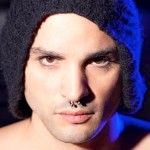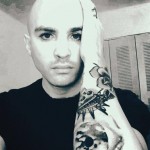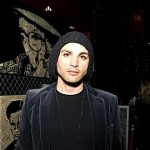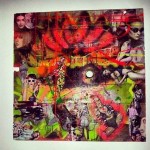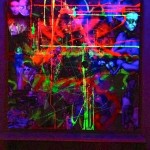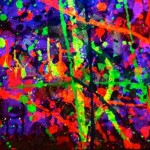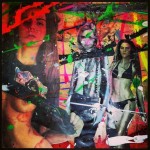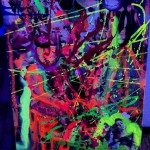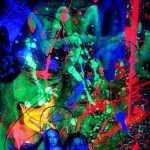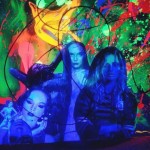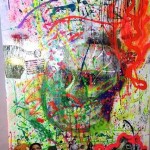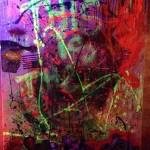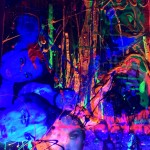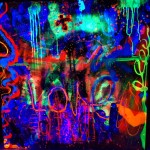by Sabrina Boasman
With his thick eyelashes and dark, sexy stare, Eddy Bogaert looks like the gentleman of your dreams. But he has more to offer the world than his looks—he’s gaining recognition for his talents as a visual artist. Discovered by a modeling scout a few years ago while he worked as a bartender, Bogaert took the plunge and moved to New York City to tackle this new career. He hit the ground running and was featured in runway shows and fashion editorials. During his downtime, Eddy decided to pursue his passion for art. His mixed-media creations are a combination of collage, splatter painting, and found objects and images. Drawing inspiration equally from high fashion, street style, nightlife, and pop culture, he incorporates comp cards from fellow models into his work, as well as editorial images and pictures he has taken himself. Though never formally trained, he has a modern approach and a strong visual aesthetic that have led to comparisons to such contemporary artists as Mr. Brainwash and Sam Francis; and he has been described as a “modern Jackson Pollock.” Bogaert considers technology and its effect on imagery, purposely creating layered works that go beyond the one-dimensional and change with different lights.
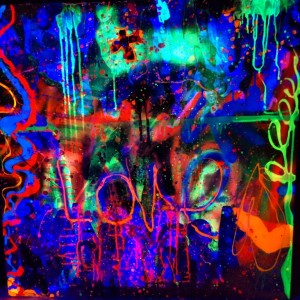 L’Etage: How would you describe your style of art?
L’Etage: How would you describe your style of art?
EB: I like to describe it as “chaotic balance.” At first glance, it may appear to be random and without direction—but as you let the painting envelope your senses, you will find that a subtle balance begins to emerge.
What I usually say is, my art is based on many things, but—one theme I would like to elaborate on is about how when someone meets someone else for the first time, they met their “representative.” Very few times do we meet the true person…people are usually wearing a mask, which in acting is called “the public persona.” I use this in my art. With regular light, one can see my work as one-dimensional. One doesn’t get the full effect of the art until the black light goes on.
The black light represents the inner person, the truth. With the black light, one can see the art with more detail. It pops out from the canvas, almost like 3-D; and something you could see before disappears, and new things appear. It’s the darker yet more interesting side of the human mind. And when the lights are off, one can see a subliminal message…of the duality of humanity, bringing to mind public personas and pop icons
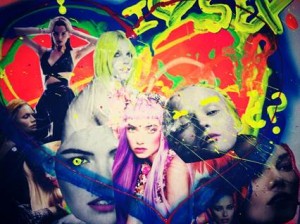 L’Etage: What techniques do you use to create your paintings?
L’Etage: What techniques do you use to create your paintings?
EB: I would say the only technique I use is my emotion. I believe that we are not always who we say we are. People tend to hide behind their layers. In my art, I am focusing on revealing these layers.
L’Etage: When you use images of a certain model, what makes you choose that face or particular girl?
EB: Usually their beauty draws me to them. Most of my art has an undertone of sexual attraction, passion, and desire; so I choose the images according to my own preferences and what intrigues or arouses me.
L’Etage: You’ve said your artwork tells stories. Are the stories your experiences or the models’?
ED: The stories are mine; what I am feeling, my thoughts, and the emotions that surround me as I am painting. I have a diverse cultural heritage and have experienced life in many countries around the world. My art is like my life and is rich with many layers, which add a complexity to my work. My work uses a variety of techniques. With their complex layers, the paintings have discreet subliminal messages. These can be seen under certain lighting conditions if one is paying close attention.
L’Etage: Where have you shown your work?
ED: I have shown at Loftwoods, which is an amazing photography studio owned by Michael Eisenberg; a few stores in New York City, such as Y-CLAD Jewelry Store and the French Corner; and at some restaurants. Recently my work was shown at Exchange Alley, in the East Village in Manhattan, and at Subject, a bar on the Lower East Side. During Art Basel, I showed at Eden Roc Hotel in Miami Beach as well as at Prague Princess in South Beach.
L’Etage: Do you have favorite ways of explaining your art or yourself?
ED: Life is my main inspiration. Everything about it—the chaos, the tranquility. I also say, ‘Look inside an empty box. You see nothing, but if you use your imagination, you can see a whole different world.’ My artwork is a door. I am just showing you how to open your mind.



